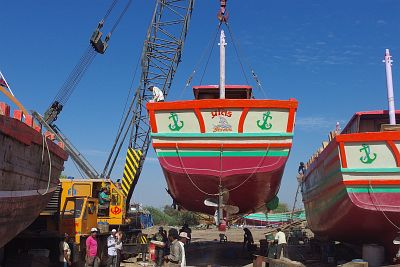Gujarat 2018
(vero;2018-Oct-31)
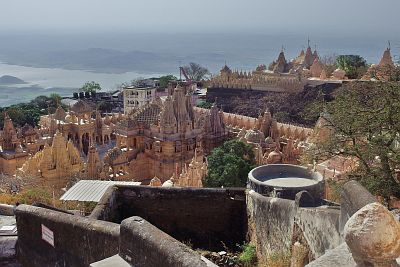 We had already been in Gujarat in 2008: after a few days in Ahmedabad we had moved on to Vadodara and from there visited the ruins of Champaner as a day trip. This time we wanted specifically to tour the Saurashtra peninsula and its hill-top Jain temples and did not want to miss the Sun temple of Modhera in the north of the state next to the border with Rajasthan.
We had already been in Gujarat in 2008: after a few days in Ahmedabad we had moved on to Vadodara and from there visited the ruins of Champaner as a day trip. This time we wanted specifically to tour the Saurashtra peninsula and its hill-top Jain temples and did not want to miss the Sun temple of Modhera in the north of the state next to the border with Rajasthan.
Our guidebook introduced Gujarat as one of India's wealthier and most industrialised states (sic) but this is definitely not the impression we got when travelling through Saurashtra: the infrastructures in the peninsula are in a bad shape and many towns dusty and rather neglected but all this did not prevent us from having a great time exploring the region. Make sure to check our photo galleries for pictures of the Saurashtra peninsula, the amazing shipyards of Veraval and the Sun Temple at Modhera.
Palitana
The town is rather small but after hectic Mumbai it was the perfect introduction to rural Saurashtra. After ambling through the streets we settled in front of the vegetable market and engaged in our favourite occupation in India: people watching.
People were friendly and as usual quite eager to speak with us, if only to know our names and where we came from. Many animals roamed the streets, goats but mostly cows which ambled innocently and never missed a chance to snap vegetables from an inattentive vegetable seller or a careless shopper who had left his shopping bag unattended while chatting to a friend!
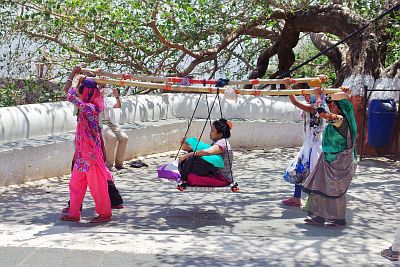 We were of course in Palitana to visit the hill-top Jain temples next to town: hundreds of them (with estimates ranging between 863 and 1008), clustered around the twin summits of Shatrunjaya Hill, one of Jainism's holiest pilgrimage site. There are many pilgrim hostels at the foot of the hill (not open to foreigners ) and they are obviously able to cater for huge numbers of devotees. People are stopped at the site entrance and asked to exchange any plastic bag they might have with a biodegradable starch bag provided for free by the temple authorities: a good move as the site proved quite clean, specially in comparison to Girnar Hill which we visited a few days later. And then you're good to go. We started in the company of many pilgrims early in the morning: it takes 3200 steps to overcome 600 altitude meters but going up was not so difficult with many flat portions between steeper parts and since we had started early it was not too hot with a light wind to cool us.
We were of course in Palitana to visit the hill-top Jain temples next to town: hundreds of them (with estimates ranging between 863 and 1008), clustered around the twin summits of Shatrunjaya Hill, one of Jainism's holiest pilgrimage site. There are many pilgrim hostels at the foot of the hill (not open to foreigners ) and they are obviously able to cater for huge numbers of devotees. People are stopped at the site entrance and asked to exchange any plastic bag they might have with a biodegradable starch bag provided for free by the temple authorities: a good move as the site proved quite clean, specially in comparison to Girnar Hill which we visited a few days later. And then you're good to go. We started in the company of many pilgrims early in the morning: it takes 3200 steps to overcome 600 altitude meters but going up was not so difficult with many flat portions between steeper parts and since we had started early it was not too hot with a light wind to cool us.
The temple area is huge and when we arrived on top we were more reminded of a fort than of a temple compound. Inside the ramparts the temples are scattered on three levels. Most of them have been built in the 16th century and many are not in a very good shape on the outside, restored with concrete, the plaster covering them often crumbling and there was a lot of renovation work going on. The interiors of the temples are adorned with many shrines containing statuettes of deities and some fine carved ceilings or columns.
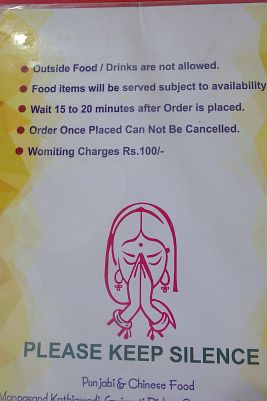 But it is not so much the temples that make Palitana so special, it is mostly the experience of being there in itself: climbing the hill with the pilgrims, some of them going with socks only or even barefoot, others being carried on dolies by two or four porters. It is a great atmosphere. And once at the summit, the views are very rewarding. When they are at the temples, the pilgrims prepare for puja and gather for chanting ceremonies. The men change clothes and put on a white robe, some of them wear a mask on their mouth and nose to prevent them from aspirating or swallowing innocent insects. There are roses everywhere, brought as offerings, and a strong scent lingers around the temples, probably reinforced by the sprinkling of rose water on the buds.
But it is not so much the temples that make Palitana so special, it is mostly the experience of being there in itself: climbing the hill with the pilgrims, some of them going with socks only or even barefoot, others being carried on dolies by two or four porters. It is a great atmosphere. And once at the summit, the views are very rewarding. When they are at the temples, the pilgrims prepare for puja and gather for chanting ceremonies. The men change clothes and put on a white robe, some of them wear a mask on their mouth and nose to prevent them from aspirating or swallowing innocent insects. There are roses everywhere, brought as offerings, and a strong scent lingers around the temples, probably reinforced by the sprinkling of rose water on the buds.
We walked back into town and rewarded us with a bottle of cool coke which we drank in front of a shop selling linoleum in the company of the shop keeper, 87 and his son, 56 soon joined by a street vendor who had sold us 500 g of rusk the day before: a nice way to finish the day.
Diu
Diu is a small island connected to the peninsula by a bridge, an ex-Portuguese trading post and a magnet for local tourists who come here to enjoy the beach and the fact that being a Union Territory, it is not subject to Gujarat's prohibition laws on alcohol. We arrived on a Sunday and there were quite a lot of Indian tourists fooling around, our second day was definitely quieter.
The place does not feel Indian but the Portuguese heritage is not so present as in Goa: there are a few imposing and colourful old houses, three Jesuit churches which have seen much better days, ramparts surrounding the town which you can walk upon, a fort… enough to spend a pleasant day wandering around. The following day we took the bus to the fishing village of Vanakbara which was quite lively with a religious festival and a busy harbour.
We walked all the way back to Diu; Nagoa beach was quite pleasant, fronting a nice bay and shadowed by palm trees. Continuing to Fudam we met old people who were quite disappointed that we could not speak Portuguese with them. Diu has surely much potential and although the place looks like paradise compared to the other dusty and charmless towns we saw in Saurashtra, we were happy to move on: we are not beach people and unlike some French tourists we met and who stayed ten days on the island, we did not feel like lingering.
Veraval came as a complete surprise and turned to be THE revelation of this trip. Not because of the famous Somnath temple which we dutifully visited but thanks to its amazing shipyards. We spent our first day exploring the yards, watching men building the ships, and two completed ships being prepared and taken away to their launching pads. It was fascinating to see the bustle of activity and the people working there were extremely kind to us, letting us climb into the ships, showing us what they were doing, bringing interesting features to our attention. We experienced something which due to safety regulations is now totally impossible in our countries and climbing into the ships was sometimes a bit shaky, but definitely worth it. We were so impressed that we have dedicated a photo gallery to the shipyards.
We visited the famous temple of Somnath on our second day. We were not much impressed by the temple itself but we found the main puja ceremony very interesting. First in line were some people rich enough to pay for the privilege of a “private” puja. They had gathered by a side door to the inner sanctum, where we just happened to sit and seemed very full of themselves, laden with ostentatious offerings. A temple officer appeared and led them into the inner sanctum by a side door and it is only after they had paid their respects, left even more money and received a blessing from the temple priest that the “ordinary” devotees could partake in the 12:00 puja. The crowds by then had been flowing through the main temple door and were waiting in lines, separated by gender. When the door to the inner sanctum opened at last, they began to press forward to the front of the inner shrine where they only had a few seconds for a bow, a stroke of the railing and a tikka before being pushed away to make space for the people behind them. When all had passed the inner sanctum, its door closed and many devotees came back to the inner temple which was by now filled with incense smoke and started chanting a kind of incantation, some of them entranced and clapping in their hands.
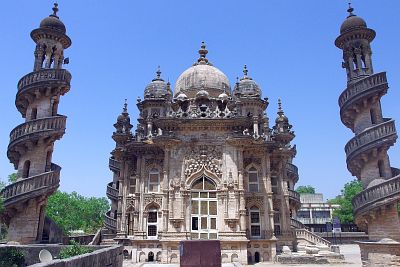 Junagadh and the Jain temples of Girnar Hill
Junagadh and the Jain temples of Girnar Hill
Junagadh is the nearest town to another very holy Jain pilgrimage site: Girnar Hill. The proceedings are very similar to Palitana just that the climb is longer with around 7000 steps to overcome. Again we started early but there were not so many people around and many stalls along the way were closed. The way is a huge staircase and unlike in Palitana, there are no flat portions in betweeen. The first part of the climb went through woods and we made it to the first cluster of temples in one and a half hour. After this first stop it is up again with a bad surprise near the end: to reach the last temple, one has to climb DOWN around 150 altitude meters before climbing them back again, quite a blow as at this point of the journey, the sun is high in the sky, there is no shadow around and the wind has ceased to blow. This did not stop the pilgrims around us and we all continued. The path was much dirtier than in Palitana, even smelt of urine on the last stretch.
The temples on Girnar Hill are not so nice than the ones in Palitana, but the landscape and the views are much better, so we would recommend to anyone touring Saurashtra to simply climb both!
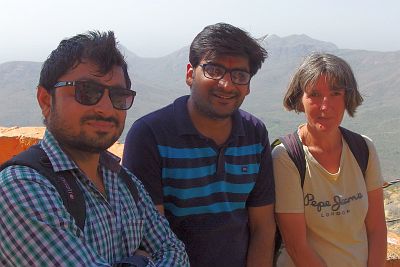 We were about to leave the last temple when suddenly, a young man stormed in panic out of the inner sanctum, followed by a furious pandit. An other young man intervened and stepped in to prevent the pandit to beat his friend and all the while a policeman on duty at the temple did nothing but looking worried that Thomas, who was just exiting the sanctuary as well might be caught in the shuffle. What a commotion! As the pandit finally retreated back into his temple, we stayed with the two young men who told us what had happened: they had performed puja and received a tikka from the temple's priest for which the first young man refused to give money as there was no money box in the sanctuary and it was clear that the pandit would pocket the money for his own needs instead of giving it to the temple community, which is highly reprehensible, a fact unfortunately widespread which the young man resented strongly and did not want to endorse. Of course, the pandit felt outraged and reacted incredibly violently. It was quite scary and I was quite impressed by the courageous man who dared facing the pandit to defend his friend.
We were about to leave the last temple when suddenly, a young man stormed in panic out of the inner sanctum, followed by a furious pandit. An other young man intervened and stepped in to prevent the pandit to beat his friend and all the while a policeman on duty at the temple did nothing but looking worried that Thomas, who was just exiting the sanctuary as well might be caught in the shuffle. What a commotion! As the pandit finally retreated back into his temple, we stayed with the two young men who told us what had happened: they had performed puja and received a tikka from the temple's priest for which the first young man refused to give money as there was no money box in the sanctuary and it was clear that the pandit would pocket the money for his own needs instead of giving it to the temple community, which is highly reprehensible, a fact unfortunately widespread which the young man resented strongly and did not want to endorse. Of course, the pandit felt outraged and reacted incredibly violently. It was quite scary and I was quite impressed by the courageous man who dared facing the pandit to defend his friend.
The town of Junagadh itself is worth a visit with a fort, some pretty mausoleums and an old town with ghost-like buildings falling into ruins, all reminders of the brilliant past of the Nawabs of Junagadh. When independence came, the then reigning Nawab wanted his state to become part of Pakistan, a decision strongly opposed by the mostly Hindu population, so he simply left on his own and his empty palace and other princely buildings have been slowly falling into disrepair since then.
Ahmedabad and the Sun temple of Modhera
Ahmedabad is a huge polluted metropolis plagued by traffic and can feel a bit daunting at first but its core, the old city, is absolutely worth a visit boasting numerous wonderful Islamic buildings and a vibrant bazaar. We spent an evening in the Ambawadi district on the other side of the river, a pleasant modern and bright part of town.
We used Ahmedabad as a base to visit the magnificent Sun temple of Modhera as a day trip, taking a first bus to Mahesana and a second local one to the village of Modhera. Maybe a bit of a long drive, but easy to do in one day. Check our photo gallery for pictures of the Sun Temple
Want to read more? Go back to Bye Sri Lanka, Hello India or go on to Pakistan-India Border Ceremony or go up to Blog
$ updated from: Blog.htxt Mon 28 Apr 2025 14:55:28 trvl2 — Copyright © 2025 Vero and Thomas Lauer unless otherwise stated | All rights reserved $




